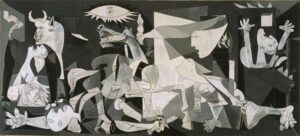No wonder I was attracted to the black and white films that I blogged about in my last post, “The Children Are Watching.” I grew up watching Italian neorealist cinema by Federico Fellini and Vittorio De Sica, albeit they were strictly censored by the Franco regime. I used to go with my parents late in the evenings, even on school nights. We would have a light, late supper and walk fast to the Tivoli Theater in our neighborhood in Madrid. The faces of Giuletta Massina and Marcello Mastroianni are forever etched in my memory. But nothing compares to the first time I saw Pablo Picasso’s Guernica – not a film, but a mural in the same black and white palette.
My family arrived to the United States on September 3rd of 1961. We landed in New York’s La Guardia Airport to continue a few days later to Seattle, where my father was invited under the auspices of the Fulbright Program at the University of Washington. It was the first time any of us had been on an airplane. I remember what I wore for the flight: a red suede jacket, a blue pleated skirt (made from one of my mother’s) and a light sweater she had knitted just for this memorable occasion. The outfit was completed by white gloves and I carried what it was called then, a “makeup case.”
On the first day in New York City my father, as he had promised, took us to see the iconic Guernica to MoMa, where it was housed then. I recall that it was displayed atop a stairwell, all by itself on a landing, standing there, huge and somber. My father had told us that Picasso painted it in just three weeks to commemorate the bombing of the Basque town of the same name by the German Luftwaffe that supported Franco’s forces during the Spanish Civil War. More than one thousand residents were killed by the air raid and the painting represented Spain in the Paris International Exhibition of 1937. I’m sure my father analyzed it for us with his encyclopedic knowledge and critical eye for detail. I can only image what it must have meant to him, who fought against Franco in the Spanish Civil War. My mother, my brother and I probably listened quietly in awe.
The Cubist mural measures 11.5 feet by 25.5 feet, and it is structured in the classical shape of a triptych. On the right rectangle, a woman cries with her arms extended to an opening, trying to escape from the house in flames. On the left side, a mother – of the five human figures represented, four are women— screams with a dead child in her arms. On the middle triangle, one woman carries a light and the other drags her broken knee on the ground. The only man lays shattered with a knife and a flower in his hand, perhaps a peasant working in his field. The people are noncombatants since they are barefooted. The horse in the middle also cries in despair and the proud bull on the left could represent Spain. We know that Picasso paid tribute to the bullfight in several of his works.
Picasso decreed that his mural could not be moved to Spain until a democracy was reinstated. He died in France in 1973, two years before Franco, without ever returning and Guernica remained at MoMA until 1981. I saw it in Madrid at its first Spanish home, El Caserón del Buen Retiro (an annex of the Prado Museum). I loved its installation there, with two long-side corridors displaying the original etchings and sketches, many of them in bright colors. The mural seemed even more monumental in the large space of the exhibition hall. Spaniards stood in long lines to see it for the first time; many cried in silence, in their own emotional visits.
Guernica was relocated once more at the Reina Sofía Contemporary Art Museum in 1992. I don’t like it here as much as I did when it had an entire building to itself. In fact, I won’t be satisfied until Guernica is housed at the spectacular Museo Guggenheim in Bilbao, which incidentally, doesn’t have its own collection. Where could it be a more appropriate space for Picasso’s masterpiece than the capital of the Spanish Basque country?


I am deeply grateful for your cogent analysis of Picasso’s masterpiece!
Until now, the emotional impact of the unspeakable scene, always prevented me from lingering long enough to identify the particular horrors visited upon Guernica’s population.
Thanks for your comment, Annette.
Emotional impact, indeed, Concha
Thank you for sharing your detailed explanation of Picasso’s Guernica. It’s one of the ironies of our earthly experience that tragedy and horror can inspire some of the highest forms of art imaginable. You do an excellent job of communicating the impact of viewing this painting, as I’ve never been to a museum where it was exhibited. I had no idea it was so large.
Thanks, Mike, Concha
I love this blog. I remember the power of my first seeing Guernica. I had studied it in a wonderful art history class in my little undergraduate school, Illinois Wesleyan. My memory was that I saw it at the Art Institute of Chicago, but it must have been at the MOMA. Thank you for bringing this memory back for me…the power of art.
Thanks, Alan.
You know a lot about the power of art! Concha
Gracias Concha! Muy emocionante! También me acuerdo de verlo en el MoMa en 1973 cuando llegué a los EEUU.
Todavía lo veo en mi mente y muchas veces he pensado en Guernica mientras estaba leyendo uno de nuestros libros.
Cuánto me alegro que te inspire, Cécile.
Abrazos, Concha